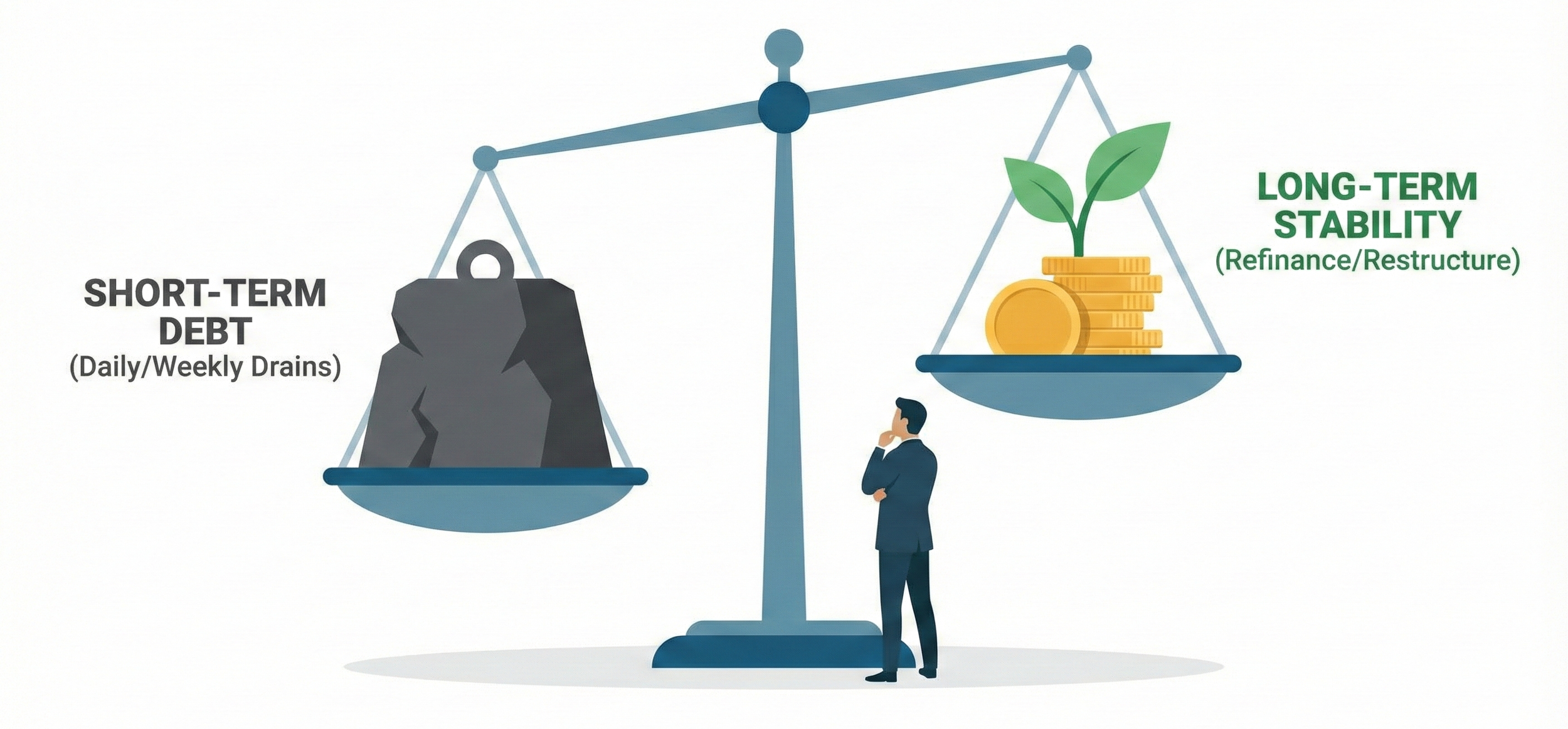General Requirements (takes about 5-minutes or less to apply online)
680+ FICO score (Transunion or Experian FICO model 8.0 or similar)
Less than 15% operating loss in the last year of business
Last 2-Years of filed Business Tax Returns; Last 1-Year of filed Personal Tax Returns
Last 3-months of bank statements; copy of Driver’s License
Business Margin Tightening:
Dealing with Margins Being Squeezed
In today’s volatile business environment, many small business owners are facing a relentless challenge: shrinking profit margins.
Costs are rising across the board—from materials and labor to overhead and logistics—while pricing power remains limited in increasingly competitive markets.
This margin squeeze doesn’t just chip away at profits; it threatens the stability, growth, and long-term viability of the entire business.
Understanding why margins are tightening and how to respond quickly and strategically is now essential for survival.
In this article, we’ll unpack the root causes of margin compression and provide practical, actionable strategies to help you reclaim profitability and strengthen your business from the inside out.
Understanding Margin Squeeze
in a Changing Economic Landscape
Every small business owner has felt the tightening grip of margin pressure at some point.
In today’s economy, with inflation, wage demands, supply chain constraints, and shifting consumer behavior all playing a part, margin compression has become more common and more damaging.
The concept is simple but the implications are severe: the cost to run your business increases faster than the price at which you can sell your goods or services, effectively shrinking the profit margin.
Whether you're a retailer, a service provider, a manufacturer, or a digital entrepreneur, your margins are under threat.
Business margin tightening doesn’t usually happen overnight.
It creeps in gradually, the result of dozens of micro-changes in the cost structure and pricing dynamics that go unnoticed until the monthly profit and loss statement raises red flags.
Understanding what’s causing the squeeze is the first step in fighting back.
Spotting the Early Signs of
Margin Compression
Most small businesses don’t have armies of analysts watching their numbers.
That means the warning signs of margin erosion are often missed until it’s already become a serious problem. Catching it early can make a big difference.
Pay close attention to subtle changes in your gross profit percentage month over month.
Are your materials, supplies, or input services getting more expensive?
Are you discounting more heavily or offering more incentives just to maintain sales volume?
Have your utility bills or freight charges crept up without a corresponding increase in sales prices?
All of these are indicators that your margin may be under pressure.
Another important red flag is the inability to grow profits despite increasing revenue. If you're selling more but not making more, something is eating away at your margins behind the scenes.
The Hidden Culprits:
Costs You Can’t See Easily
Many business owners understand the impact of obvious cost increases—like a higher rent or rising employee wages—but often miss the more hidden costs that slowly sap margins.
One example is software creep, where subscriptions to tools and platforms add up quietly in the background.
Another is process inefficiency—if your team is spending 20 percent more time on a task than before due to outdated tools or lack of training, that time is money lost.
Shrinkage, spoilage, and rework are other hidden profit-killers.
So is customer churn.
If you're constantly having to replace lost clients or accounts with costly new customer acquisition efforts, you're leaking margin from both ends.
The more you drill into your cost layers, the more opportunities you'll find to plug profit leaks.
Start with a deep dive into your expense categories from the last 12 months and compare them to the previous period.
Look for line items that have grown faster than revenue.
Those are the culprits demanding your immediate attention.
Pricing Pressures:
When Raising Prices Isn't So Simple
Pricing is the most direct lever to improve margins—but it’s also one of the hardest to pull.
In competitive markets, customers are quick to push back on price increases, and competitors may undercut you to gain market share.
If your offerings are viewed as commodities, raising prices may not even be feasible.
Yet not adjusting prices in the face of rising costs is a guaranteed way to shrink your margins.
The key is finding the balance between maintaining competitiveness and preserving profitability.
That starts with knowing your value proposition inside and out.
If your business delivers unique value—faster delivery, better service, specialized expertise, or a premium experience—then your price should reflect that.
You’re not selling the same thing as everyone else, so you shouldn’t price like everyone else.
Also consider creative pricing strategies, like bundling, tiered pricing, subscription models, or minimum order thresholds to protect your margins.
Sometimes, reframing the offer is more effective than a blunt price hike.
Instead of raising the price of a single product, create a bundled offer at a higher ticket but greater value. This lets you protect unit economics while improving customer satisfaction.
Reining in Overhead and
Fixed Costs
Overhead is often the silent killer of profitability.
Unlike variable costs, which scale with revenue, overheads stay put—or worse, increase—even when sales decline.
Office space, insurance, professional fees, equipment leases, and other fixed commitments can strangle your business’s financial flexibility.
In today’s economic environment, no overhead should be considered untouchable.
That doesn’t mean slashing to the bone or compromising quality, but it does mean being ruthless in reevaluating every line of your operating structure.
Can you renegotiate your lease or switch to a coworking model?
Can you reduce your dependency on expensive professional services by bringing key functions in-house?
Could part of your team shift to remote work, lowering utility or workspace costs?
Even small cuts across multiple overhead categories can add up to significant margin relief over time.
This is especially true in businesses with seasonal swings or unpredictable revenue streams.
Trimming the fixed cost burden gives you breathing room when times get tough.
General Requirements (takes about 5-minutes or less to apply online)
680+ FICO score (Transunion or Experian FICO model 8.0 or similar)
Less than 15% operating loss in the last year of business
Last 2-Years of filed Business Tax Returns; Last 1-Year of filed Personal Tax Returns
Last 3-months of bank statements; copy of Driver’s License
Supplier and Vendor Management
to Protect Your Margins
Strong vendor relationships can be your secret weapon in a margin-squeezed environment.
The better your relationship with your suppliers, the more room you have to negotiate on price, terms, or flexibility.
First, review your existing supplier agreements.
Are you still getting the best terms?
Are there bulk pricing tiers or rebates you're not taking advantage of?
Can you shift volume between vendors for better rates?
Second, consider consolidating vendors.
Larger volume with fewer suppliers can improve your bargaining position.
You might also benefit from longer payment terms or early pay discounts—both of which can strengthen cash flow and reduce margin pressure.
Lastly, collaborate with vendors to explore cost-saving opportunities.
Maybe they can offer a more economical product variation or help you reduce packaging costs.
When vendors understand your goals, they may bring solutions to the table that help both parties.
Streamlining Operations for
Margin Efficiency
Operational efficiency has a direct impact on your margin profile.
When things run smoothly, you produce more, waste less, and increase throughput without increasing overhead.
But inefficiencies—redundant processes, manual work, disorganized inventory, and unclear roles—waste time, money, and momentum.
Start by mapping out your key business processes. Look for bottlenecks, repetitive tasks, or handoffs that create confusion or delay.
Can these processes be automated or streamlined?
Technology can help, but it’s not always about buying new software.
Sometimes, it's about better using the tools you already have.
Train your team to fully leverage existing platforms.
Implement standard operating procedures that are easy to follow and measure.
Set performance metrics that are tied to margin contribution, not just volume or revenue.
When you commit to operational clarity and simplicity, you not only preserve margin—you build a more resilient business capable of scaling.
Labor Costs and
Productivity Alignment
Labor costs are rising across industries, and small businesses are especially vulnerable to wage inflation.
But cutting hours or staff isn’t always the answer—it can hurt morale, reduce capacity, or affect customer satisfaction.
Instead, focus on productivity alignment.
Are your employees contributing at levels that justify their compensation?
Are your team members empowered with the right tools and training to do their jobs efficiently?
Cross-training employees, using part-time or contract labor during peak periods, and aligning incentives with profit outcomes are smart ways to manage labor costs without simply reducing headcount.
You want a lean, high-performing team that scales with demand, not a bloated one that eats into profits regardless of output.
A regular labor productivity review—comparing payroll against output, service volume, or margin contribution—can reveal hidden inefficiencies.
Address these gaps with coaching, performance management, or resource reallocation rather than blanket cuts.
Customer and Product Profitability Analysis
Not all customers are created equal.
Neither are all products.
Yet many businesses treat them as if they are.
One of the most impactful things you can do to protect your margins is to segment your customers and offerings by profitability.
Start by analyzing your sales by product or service line, then layer on gross profit and net profit for each.
Which offerings have the highest margins?
Which ones require the most time or resources for the least return?
Are there “loss leaders” that you’ve never revisited?
Next, apply the same lens to your customers.
Some clients may consistently demand more service, more time, or customizations that drain your margin.
Others may order regularly, pay on time, and require minimal effort.
Once you identify these patterns, you can strategically raise prices, adjust service levels, or even exit unprofitable relationships.
Focus your energy and resources on high-margin offerings and high-value clients.
Tailor your marketing, operations, and sales strategy around what actually moves the margin needle—not just what generates top-line revenue.
Building a Margin-First Culture
Across the Organization
Protecting and growing margins isn’t the job of the finance team alone.
Every employee—from the front line to the back office—should understand how their decisions impact profitability.
When margin awareness becomes part of your company culture, you build a team that thinks like owners.
Communicate your financial goals clearly.
Share key metrics and celebrate wins tied to efficiency, cost control, and customer profitability.
Encourage employees to suggest cost-saving ideas and reward margin-positive behavior.
Implement accountability systems that tie bonuses, performance reviews, or team recognition to margin-related outcomes.
Whether it’s reducing waste, upselling higher-margin services, or improving customer retention, every team member can contribute.
Over time, a margin-first mindset fosters smarter decisions, leaner operations, and better alignment with the business’s financial health.
And that cultural shift can be one of your most powerful defenses against ongoing margin tightening.
Strengthen Margins,
Strengthen the Business
Margin pressure is a reality of modern business—but it doesn’t have to be a death sentence.
By approaching margin tightening with curiosity, discipline, and strategic focus, small business owners can regain control of their bottom line and build a more durable business.
Start with visibility: know your numbers, your cost structure, and your true profitability by product, customer, and channel.
Then act with intention—adjust pricing, renegotiate vendor terms, streamline operations, and align labor costs with output.
Most importantly, build a business culture that values profit as much as purpose.
When margins are strong, businesses have the flexibility to invest, grow, and weather economic storms.
And in a world of uncertainty, that flexibility is your greatest competitive advantage.
WHAT IS THE BEST AND SAFEST WAY FOR YOUR BUSINESS TO DEAL WITH HIGH BUSINESS DEBT PAYMENTS?
It is NOT by stopping ACH payments.
It is NOT by taking on another business loan.
It is NOT ALWAYS a Refinancing
It is NOT by entering into a debt settlement program.
Find out the BEST strategies to get your Business back to where it was



















